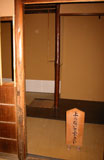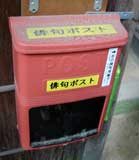Gyokusenen Niwa (Garden)
Kanazawa has a very large and very famous garden called Kenrokuen, which is reputed to be one of the three nicest gardens in Japan. Much smaller but very nice on its own terms is Gyokusenen Niwa. Gyokusenen has a fascinating history: it was started in the early Edo period by Naokata Wakita (family name last), who was originally Korean and brought back from Korea as a child after a military expedition. As you can see from the pictures, the garden is an extraordinary and beautiful place.
Naokata must have had some extraordinary qualities, for he was eventually made a chamberlain of the Kaga clan (lords of the feudal domain that included Kanazawa). In addition to his Korean origin, Wakita was a 'secret Christian', and there are carvings in the garden (not pictured) that contain references to attempts to practice Chrsitianity after it was forbidden by the Shogunate government in 1597. Christianity officially became extinct in Japan around 1638.

















